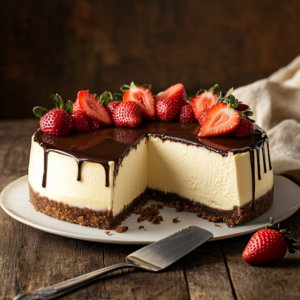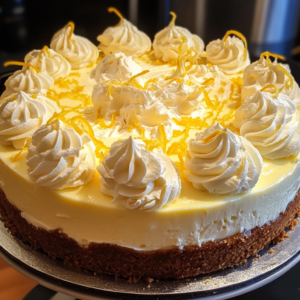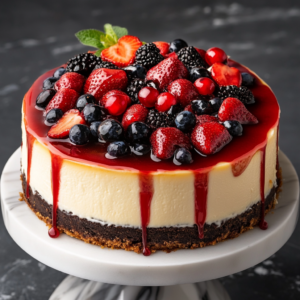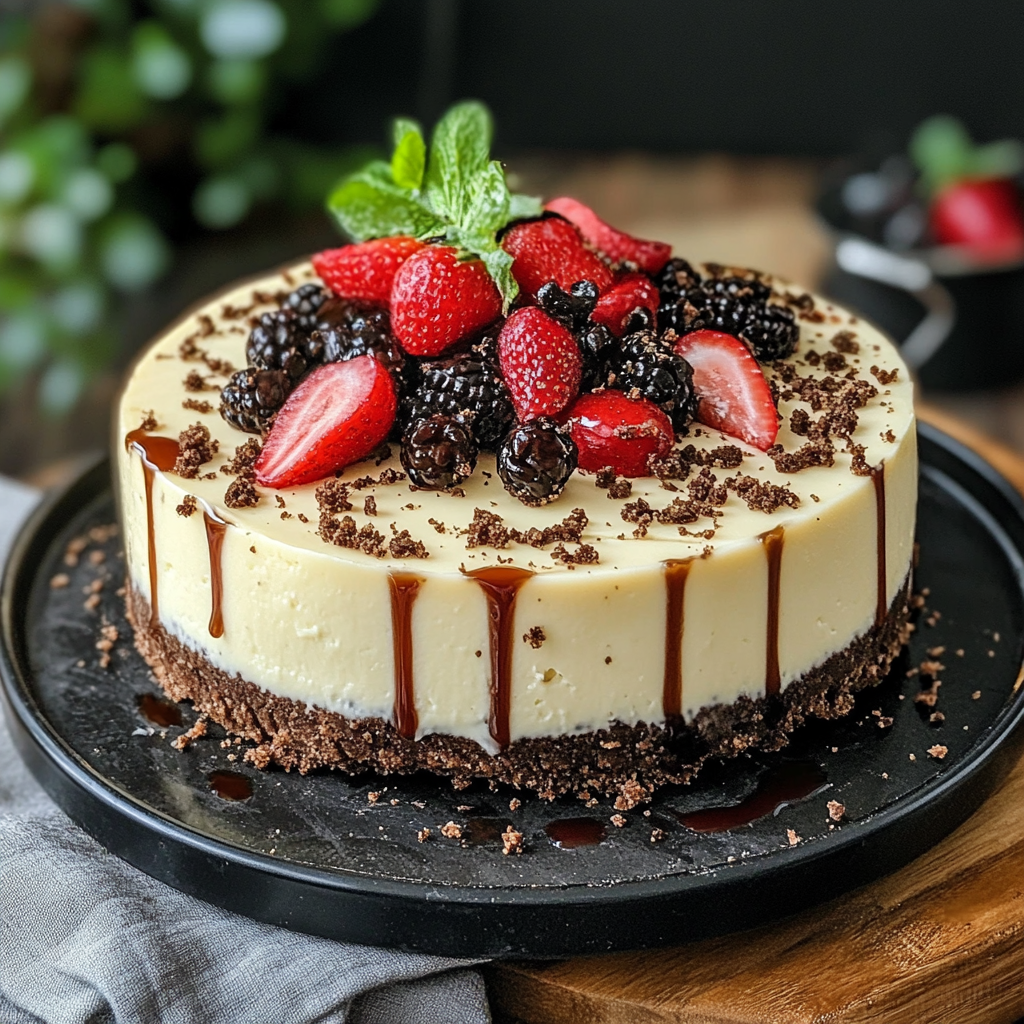If you’re a cheesecake lover, the Philadelphia cheesecake recipe is a must try. Known for its smooth, creamy texture and perfectly balanced sweetness, this dessert has become a staple in bakeries and homes alike. Whether you’re a novice baker or a seasoned pro, making a classic Philadelphia-style cheesecake at home is surprisingly simple with the right ingredients and techniques. This guide will take you step by step through the process, from preparing the perfect crust to achieving that flawless creamy filling.
Why Choose Philadelphia Cheesecake?
There are many reasons why the Philadelphia cheesecake recipe has remained a favorite for generations:
- Creaminess from Philadelphia Cream Cheese: The use of high quality, full fat cream cheese ensures a rich, luxurious texture.
- Balanced Sweetness: Philadelphia cheesecake is sweet but not overly sugary, making it a crowd pleaser.
- Versatility in Toppings: From fresh berries to chocolate drizzles, the cheesecake pairs beautifully with a variety of toppings.
- Perfect for Any Occasion: Whether for birthdays, holidays, or casual dinners, this dessert is always a hit.
Tools and Equipment for Perfect Cheesecake
Having the right tools makes the process of baking a Philadelphia cheesecake recipe much smoother. While you don’t need fancy gadgets, a few essential items can ensure the best results:
- Springform Pan: This allows you to easily release the cheesecake without damaging the crust or sides.
- Electric Mixer: A hand or stand mixer ensures your cream cheese blends smoothly with other ingredients.
- Measuring Cups and Spoons: Precise measurements are key to achieving the correct texture and flavor.
- Roasting Pan: If you’re using a water bath, a large roasting pan is necessary.
- Offset Spatula: Useful for smoothing out the filling and releasing the cheesecake from the sides of the pan.
Investing in these basic tools ensures that every step of the Philadelphia cheesecake recipe goes off without a hitch.
History of the Philadelphia Cheesecake
The history of Philadelphia cheesecake can be traced back to the 19th century when cream cheese was first mass produced in the United States. Contrary to popular belief, Philadelphia-style cheesecake doesn’t refer to a regional origin but rather to the use of smooth Philadelphia Cream Cheese. The name became associated with premium quality, and by the 20th century, Philadelphia cheesecake was known for its light, creamy consistency. Today, it remains a popular choice worldwide, with home bakers and professional chefs alike embracing its simplicity and versatility.
Vegan and Dairy-Free Alternatives
For those who follow a vegan or dairy free diet, it’s possible to create a delicious cheesecake using substitutes without sacrificing texture or flavor. Vegan Philadelphia cream cheese is now widely available and works wonderfully in this recipe. Instead of eggs, you can use ingredients like silken tofu or aquafaba (the liquid from chickpeas) to create the necessary structure and creaminess.
For the crust, simply swap out butter for vegan alternatives like coconut oil or plant based margarine. Additionally, plant based yogurts and coconut cream make excellent replacements for sour cream. When baked properly, these alternatives yield a cheesecake that’s just as smooth and satisfying as the original. This variation ensures that everyone, regardless of dietary restrictions, can enjoy the deliciousness of Philadelphia cheesecake.
Looking for a protein-packed alternative? Try these delicious and healthy cottage cheese wraps as a lighter snack option.
Essential Ingredients for Philadelphia Cheesecake

To achieve that smooth, creamy texture, you’ll need just a few basic ingredients:
- Philadelphia Cream Cheese (4 blocks, 8 oz each) – Ensure it’s softened for easier mixing.
- Granulated Sugar (1 cup) – Adds sweetness and enhances the cream cheese flavor.
- Sour Cream (1 cup) – Balances sweetness with a touch of tanginess.
- Vanilla Extract (1 tsp) – Adds depth of flavor to the filling.
- Eggs (4 large) – Provides structure while maintaining the cheesecake’s creamy texture.
- Graham Crackers (1 ½ cups, crushed) – Forms the base of the crust.
- Unsalted Butter (½ cup, melted) – Binds the graham cracker crust together.
Step-by-Step Instructions for the Perfect Philadelphia Cheesecake
1. Prepare the Graham Cracker Crust
- Preheat the oven to 325°F (163°C).
- Mix the crushed graham crackers with melted butter and 2 tablespoons of sugar.
- Press the mixture firmly into the bottom of a 9-inch springform pan to form an even crust.
- Bake for 10 minutes and allow it to cool while you prepare the filling.
While the graham cracker crust is a classic, there are plenty of alternative crusts to try if you’re looking to change things up.
- Oreo Crust: Crush 2 cups of Oreo cookies (with filling) and mix with melted butter. This option adds a rich, chocolaty base to your cheesecake.
- Almond Flour Crust: For a gluten free option, mix almond flour with a touch of butter and sugar. This crust has a nutty flavor that complements the creaminess of the cheesecake filling.
- Gingersnap Crust: Swap graham crackers for gingersnap cookies to add a spicy kick, perfect for fall or winter desserts.
- Biscoff Crust: For a caramelized twist, use crushed Biscoff cookies to create a unique base for your cheesecake.
These alternative crusts allow you to customize your Philadelphia cheesecake recipe to suit different tastes and occasions.
2. Make the Creamy Cheesecake Filling
- In a large mixing bowl, beat the softened Philadelphia cream cheese until smooth.
- Gradually add the sugar and beat until well combined.
- Add the sour cream and vanilla extract, mixing until smooth and creamy.
- One at a time, beat in the eggs at low speed to avoid overmixing, ensuring a silky filling.
Pro Tips for Perfect Cheesecake Filling
Here are a few pro tips to help you achieve the perfect cheesecake filling:
- Use Room-Temperature Ingredients: Make sure all your ingredients—especially cream cheese and eggs—are at room temperature. This ensures the filling blends smoothly without lumps.
- Avoid Overmixing: Beat the filling just until each ingredient is incorporated. Overmixing introduces air bubbles, which can cause cracks during baking.
- Scrape Down the Bowl: Frequently scrape the sides of the bowl with a spatula to ensure all ingredients are evenly mixed.
- Add a Spoonful of Flour: If you want extra stability, you can add 1-2 tablespoons of flour to the batter. This step can help prevent cracking without affecting the texture.
3. Assemble and Bake the Cheesecake
- Pour the cream cheese filling into the prepared crust.
- Tap the pan gently on the counter to remove any air bubbles.
- Bake for 55-60 minutes until the edges are set, but the center still has a slight jiggle.
- Turn off the oven and allow the cheesecake to cool inside the oven with the door cracked for an hour.
Making a Water Bath for Cheesecake
Using a water bath (also called a bain marie) is an excellent way to ensure that your cheesecake bakes evenly and prevents cracks on the surface. To create a water bath, wrap the bottom of your springform pan with two layers of aluminum foil to prevent leaks.
Place the pan inside a larger roasting pan, then fill the roasting pan with hot water until it reaches halfway up the sides of the springform pan. This water bath provides a gentle, even heat around the cheesecake, reducing the chances of sudden temperature changes that can cause cracking. When you remove the cheesecake from the oven, leave it to cool gradually in the water bath for a smoother texture.
4. Chill and Serve
- Refrigerate the cheesecake for at least 4 hours, preferably overnight, to set completely.
- Before serving, release the springform pan and add your desired toppings.
Topping Ideas for Philadelphia Cheesecake
One of the best things about the Philadelphia cheesecake recipe is its versatility with toppings. Here are a few favorites:
- Fresh Berries: Strawberries, raspberries, or blueberries add a fruity contrast.
- Chocolate Ganache: A rich chocolate drizzle makes for a decadent treat.
- Caramel Sauce with Pecans: Add some crunch and sweetness for extra indulgence.
- Whipped Cream and Lemon Zest: Light and refreshing, perfect for warmer days.
- Espresso Powder Dusting: A light sprinkle of espresso powder adds depth and pairs well with chocolate based toppings.
Cheesecake Variations to Try
If you want to take your Philadelphia cheesecake recipe to the next level, try experimenting with these fun variations:
- Pumpkin Cheesecake: Add pumpkin puree and warm spices like cinnamon and nutmeg to the filling. This is a perfect dessert for fall gatherings.
- Matcha Cheesecake: Incorporate matcha powder into the cream cheese mixture for a subtle, earthy flavor and a beautiful green hue.
- Chocolate Swirl Cheesecake: Pour half the plain batter into the pan, then swirl melted chocolate into the remaining batter before adding it on top. This creates a beautiful marbled effect.
- Strawberry Cheesecake: Fold chopped fresh strawberries into the filling and top with a strawberry glaze. This version is perfect for springtime celebrations. Pair your fruity cheesecake with a classic twist, like this easy Bisquick shortcake recipe.
These variations offer exciting ways to customize your cheesecake to suit different tastes and occasions.
How to Customize Your Cheesecake with Flavor Extracts

In addition to toppings and mix-ins, you can customize your Philadelphia cheesecake recipe using different flavor extracts. Vanilla extract is the classic choice, but here are some other options to consider:
- Almond Extract: A few drops add a delicate, nutty undertone to the filling.
- Lemon Extract: Adds brightness and enhances fruity toppings like strawberries or raspberries.
- Coconut Extract: Works well with tropical toppings such as pineapple or mango.
- Mint Extract: Pairs beautifully with a chocolate swirl or ganache topping.
These flavor extracts give you the freedom to create unique cheesecake variations suited to your taste and the occasion. Just be careful not to overdo it—a little goes a long way!
Common Mistakes to Avoid When Baking Cheesecake
Even with the best ingredients and recipe, mistakes can happen. Here are some common pitfalls to avoid when baking Philadelphia cheesecake:
- Overbaking: Keep an eye on the center—it should still have a slight jiggle when done.
- Skipping the Water Bath: Although optional, a water bath helps prevent cracks.
- Opening the Oven Too Early: Resist the urge to check on the cheesecake too soon, as sudden temperature changes can cause it to collapse.
- Not Chilling Long Enough: For the best texture, refrigerate your cheesecake for at least 4 hours before serving.
Storage and Freezing Tips
Proper storage ensures your Philadelphia cheesecake stays fresh:
Store the cheesecake in an airtight container in the refrigerator for up to 5 days. To freeze, wrap individual slices in plastic wrap, place them in a freezer bag, and thaw overnight in the refrigerator for best results.
How to Serve Cheesecake Perfectly
Presentation matters when serving the Philadelphia cheesecake recipe. For clean slices, run a sharp knife under hot water, dry it, and make each cut carefully. Wipe the knife clean between slices to keep the edges neat.
Serve your cheesecake cold, but allow it to sit at room temperature for about 15 minutes before serving to enhance its flavor and texture. For an elegant touch, drizzle individual slices with caramel, chocolate, or fruit sauce just before serving. This small step makes a big difference in the overall presentation of your cheesecake.
Serving Suggestions for Different Occasions

The beauty of the Philadelphia cheesecake recipe lies in its versatility, making it perfect for all kinds of events. For instance, at casual gatherings, you can serve the cheesecake plain or with a simple berry topping to keep things light. Meanwhile, at formal dinners, consider decorating the top with a glossy fruit glaze or chocolate drizzle for an elegant presentation.
During the holidays, festive elements like crushed peppermint or spiced caramel sauce make the cheesecake even more seasonal. Additionally, if you’re hosting a brunch, cut the cheesecake into small squares and serve them on a dessert platter alongside other pastries. In any case, no matter the occasion, Philadelphia cheesecake always makes a delightful and memorable dessert.
Frequently Asked Questions (FAQs)
1. What makes Philadelphia cheesecake different from New York-style cheesecake?
Philadelphia cheesecake is known for its lighter, creamier texture, while New York-style cheesecake is denser due to the addition of heavy cream.
2. Can I use low-fat cream cheese for this recipe?
Yes, but the texture will be slightly less creamy. For the best results, stick with full-fat cream cheese.
3. How do I prevent cracks in my cheesecake?
Additionally, avoid overmixing the batter, and let the cheesecake cool slowly in the oven to prevent sudden temperature changes that cause cracking.
4. Can I make this cheesecake without a graham cracker crust?
For example, you can use an Oreo crust or almond flour crust as alternatives.
Final Thoughts
Ultimately, the Philadelphia cheesecake recipe offers a perfect combination of simplicity and flavor, making it ideal for any occasion. In addition, this cheesecake is a timeless dessert that’s easy to make and always impresses. Whether you’re preparing it for a special event or simply indulging a sweet craving, this creamy cheesecake never disappoints. By carefully following the tips outlined in this guide, you’ll achieve the perfect cheesecake every time. Furthermore, with endless topping options and straightforward instructions, the Philadelphia cheesecake recipe deserves a place in every baker’s repertoire. Thus, enjoy baking and sharing this delicious dessert with family and friends! For an extra twist, serve a slice of cheesecake alongside crispy chicken fries for an unexpected pairing.
